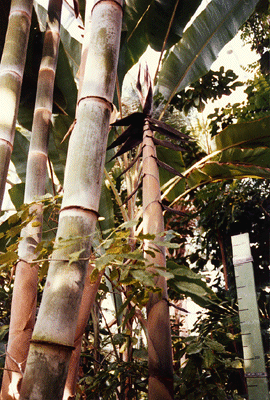Main tropical greenhouse with Welwitschia-Annex - House A
The Main Tropical Greenhouse was reconstructed from 2006 until 2009. More information about the reconstruction and energy-saving technology reconstructing here (in German).

The main tropical greenhouse, architectural symbol of our garden (and logo) is a glasshouse dating back to 1906/1907 but very modern for its time of construction. It has a ground surface of 60 x 30 m and a height of 23 m, thus ranging among the largest greenhouses of the world. It was newly covered with plexiglass in 1968. The glasshouses were designed as complementary to the phytogeographical section in the open area. Some displays follow this phytogeographical arrangement. Taxonomic groups, like orchids, ferns and bromeliads, or to plants requiring similar cultivation techniques, like succulents, water plants, and insectivorous plants, are grouped together in some houses. Within the main tropical glasshouse, the left half contains plants from tropical America, the right half plants from tropical Africa, Asia, Australia, and the Pacific region. [Photo: Giant bamboo (Dendrocalamus giganteus)] One of the largest plants in the main tropical greenhouse is not a tree but, surprisingly, a member of the grass family, the giant bamboo Dendrocalamus giganteus, from SE-Asia. The culms reach 15 cm diameter and 26 m height. Terminalia catappa also reaches the roof, and various lianas do the same. The most impressive is probably Alsomitra macrocarpa of the cucurbit family. Various fig trees (genus Ficus), among them Ficus schlechteri with conspicuous arial roots, and the well-known Ficus benjamina can be found here. Other examples in the Old World section are Kigelia africana, Parkia javanica and several palms. Pandanus utilis and P. tectorius show their stilt roots. The tall Strelitzia nicolai is sometimes confused with a banana plant. The oldest plants in this house are several specimens of cycads, which are probably more than 150 years old and were already cultivated in the precursor of the Dahlem garden in Berlin-Schöneberg. Encephalartos altensteini,Cycas rumphii and C. revoluta, and the neotropical Dioon edule are the most impressive ones. In the New World part of the house, some tall and showy palms represent this important tropical family. Roystonea oleracea, Syagrus romanzoffiana, Coccothrinax argentea, Sabal blackburniana, Washingtonia filifera, and W. robusta are dominating. The slender Chamaedorea palms and also the neotropical Cyclanthaceae with Cyclanthus bipartitus and Ludovia lancifolia are found in the shrub layer. Among the trees, Aleurites remyi, Hura crepitans (Euphorbiaceae), and of the Bombacaceae, Bernoullia flammea, and the rather too slender Chorisia speciosa are most conspicuous. Chorisia, as well as Pseudobombax ellipticum produce their flowers high up in the crown, where they are easily overlooked. The Araceae are represented with larger specimens of Philodendron, Anthurium, and Monstera. The typically neotropical bromeliad family is shown here with few examples only because a much more diverse display is arranged in house G. Tillandsia usneoides, the most widespread bromeliad in tropical America, forms long „beards" grown here to impressive size in 30 years. Among the herbaceous plants, beautiful leaf patterns are striking particularly in Maranta and Calathea. A particular curiosity, Aristolochia arborea, is cultivated here. Its flowers do not primarily appear on the twigs where one expects them, but rather at soil level on the trunk. A small mushroom seems to be present in the throat of the brownish red flower with white lip, deceiving small flies to visit the flower and be trapped in it to serve as a pollinator. This is only a very small selection of plants on display. From here, a round trip through greenhouses B to O is possible. You should not miss a visit to the Welwitschia-annex, with large, seed-grown Welwitschia mirabilis about 50 years old. B. Leuenberger |
Continue the tour of the greenhouses...





